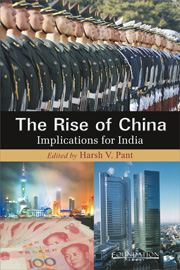Book contents
- Frontmatter
- Contents
- List of Contributors
- Preface
- 1 Introduction
- Part I Domestic Developments in China
- 2 China's Economic Rise: From Hindi-Chini Bhai Bhai to Hindi-Chini Buy-Buy?
- 3 Domestic Politics in Contemporary China: Ideas, Institutionalisation and Issues
- 4 China's Military Modernisation: Dragon Fire on India
- Part II China's Foreign Policy
- Part III China's India Policy
4 - China's Military Modernisation: Dragon Fire on India
from Part I - Domestic Developments in China
Published online by Cambridge University Press: 05 June 2012
- Frontmatter
- Contents
- List of Contributors
- Preface
- 1 Introduction
- Part I Domestic Developments in China
- 2 China's Economic Rise: From Hindi-Chini Bhai Bhai to Hindi-Chini Buy-Buy?
- 3 Domestic Politics in Contemporary China: Ideas, Institutionalisation and Issues
- 4 China's Military Modernisation: Dragon Fire on India
- Part II China's Foreign Policy
- Part III China's India Policy
Summary
China has initiated a concerted military modernisation programme in the last few decades, the impact of which is being felt in the neighbourhood, including on India. An important dimension of China's rise recently is its military modernisation programme, which was enhanced after the People's Liberation Army (PLA) suffered losses in the 1979 Vietnam War. The 1985 “structural reorganisation” plan had relatively succeeded in putting the rank and file of the PLA on the road to a “lean and mean” armed forces. Hardware and software modernisation of the PLA and double-digit increases in the defence budget allocations, in the last two decades, were to make it one of the major forces to contend with in the region. It is generally recognised that by 1999, the PLA was making a turnaround from large infantry-based armed force to that of gradually acquiring the potential to project power abroad. This was part of the strategy to transit from mechanisation to information-based warfare.
The transition in the PLA are clearly visible. On January 11, 2007, China conducted an anti-satellite test with a ground-based missile destroying one of its retired Fengyun satellites located at about 860 km in orbit. Three years later, the same day in 2010, China conducted successfully an interceptor missile test. The Chinese air force has unveiled newer versions of multi-role aircrat (J-10), while acquiring others from Russia (Su-27 and Su-30). In October 2006, a Chinese conventional submarine trailed USS Kittyhawk near Okinawa.
- Type
- Chapter
- Information
- The Rise of ChinaImplications for India, pp. 85 - 104Publisher: Foundation BooksPrint publication year: 2012
- 1
- Cited by



